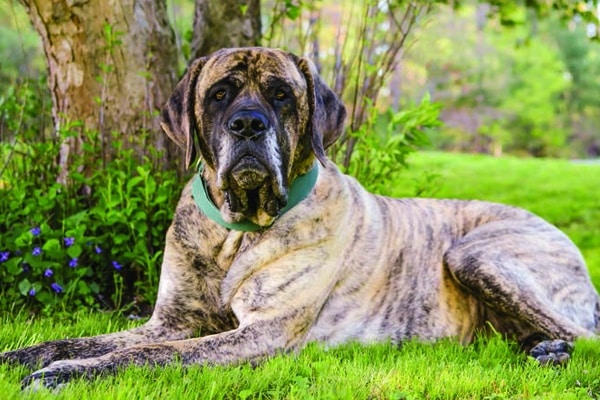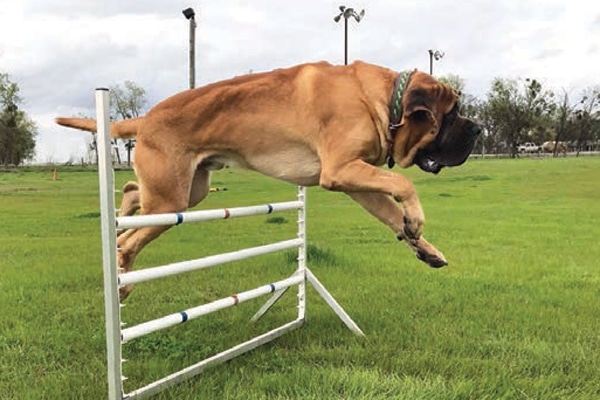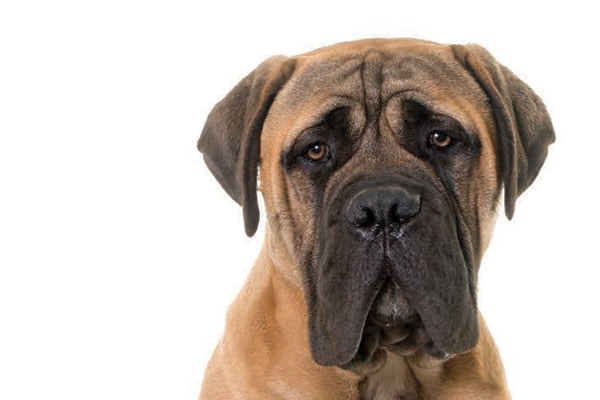Recognized for his considerable size and wrinkles, the Mastiff is an ancient breed with a dignified, self-assured personality. He fought alongside soldiers centuries ago, but these days he mainly works at home. A loyal, laid-back companion, the Mastiff rises to the occasion if needed. He won’t, however, typically run patrol in the yard or bark at every new thing. Perhaps this breed intuitively knows that at some 200 pounds, his presence alone deters ne’er-do-wells?
History of the Mastiff

With a history spanning centuries and continents, the Mastiff’s ancestors are linked to Babylonians, Marco Polo, Hannibal and British royalty. Bred to guard, fight and haul, Mastiffs were developed for courage, toughness and dependability. They are the likely ancestors of the mountain dog breeds such as the Saint Bernard.
Most historians agree that the British developed the Mastiff breed as we know him today. These early Mastiffs guarded the castles and estates of kings and nobility, and fought wild animals to entertain the royalty. Henry VIII gifted hundreds of Mastiffs to Charles V of Spain for battle. More recently, during the World Wars, Mastiffs pulled heavy carts for the military. And here in America, Mastiffs worked as guards on early plantations.
What Are Mastiffs Like to Live With?
Today the powerful Mastiff still guards his master’s castles, large or small. He also enjoys carting, tracking, obedience, weight pulling and therapy work. Training a Mastiff takes some patience; they weren’t developed for routine obedience. Families do well to train from early puppyhood, when the dog is small enough to manage. A Mastiff stays in the juvenile stage longer than most breeds, reaching full physical and mental maturity at age 3 or so.
Typically easygoing around children and with other animals if socialized, Mastiffs are good family dogs. The dog’s sheer size, however, requires accommodations indoors and outdoors. Travel and transportation may be especially challenging. After all, a Mastiff won’t easily fit in the family car’s backseat.
Feeding a Mastiff requires super-sized dog food bins. Fortunately, pound for pound the larger breeds actually eat less than the small breeds. And although large, the Mastiff’s exercise requirements are moderate. A good-sized yard is ideal, but owners in small homes can manage a Mastiff if they take him on daily walks.
Mastiff Facts

- Weight: About 140 to over 200 pounds (male), 120 to 150 pounds (female). In general, Mastiff males are significantly larger than females.
- Life span: 6 to 10 years
- Coat: Outer coat straight and coarse; undercoat dense and close
- Color: Fawn, apricot or brindle
- Equipment: The Mastiff’s powerful jaws require sturdy toys. Families also need supplies of rags and towels for messy spill cleanup.
- Grooming: Weekly brushing keeps the double coat under control. Wrinkles need to be cleaned and dried. Ears should be wiped regularly.
- Shedding: Mastiffs shed year-round; shedding may increase with seasonal changes.
- Best for: Families and singles with space for a big friend.
- Possible health issues: Joint problems such as hip or elbow dysplasia.
The Mastiff and Drool
If you’re familiar with Mudge, the Mastiff in the Henry and Mudge children’s book series (author Cynthia Rylant), you’ll know that Mudge’s drooling adds a comic element to the storylines. Indeed, breeds such as the Mastiff with big, droopy cheeks and lips are prolific droolers. The drool occurs because of the mouth’s structure, which allows saliva to pool and overflow. Drool may waterfall down the Mastiff’s face, swing out in ropey strands and eventually sit in pools on the floor. Owners will need rags and towels for swabbing, bibbing and mopping. Wiping the dog’s muzzle after he drinks water may help.
Thumbnail: ©cynoclub | Getty Images.
About the author
Originally an attorney, Lynn Hayner has been writing for companion animal publications for two decades. Also a historian, Lynn studies dog breed development throughout the world, dabbles in animal law issues, and collects dog stories as she travels across the country with her husband and German Shepherd Dog, Anja. At home in Waco, Texas, Lynn kicks the dust up dancing with Anja, as well as teaching her obedience and tricks.
Editor’s note: This article appeared in Dogster magazine. Have you seen the new Dogster print magazine in stores? Or in the waiting room of your vet’s office? Subscribe now to get Dogster magazine delivered straight to you!
Why read breed profiles?
Dog breed profiles help everyone, whether you have a mixed breed or purebred dog, to better understand and improve the quality of your dog’s life. If you have a mixed breed dog, read up on all of the breed profiles that make up your dog. Not sure what breed your dog is? There are a number of easy DNA tests out there to help your find out.






